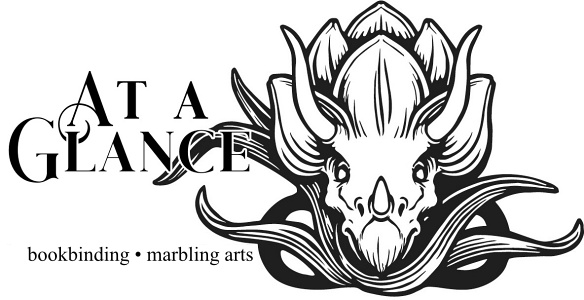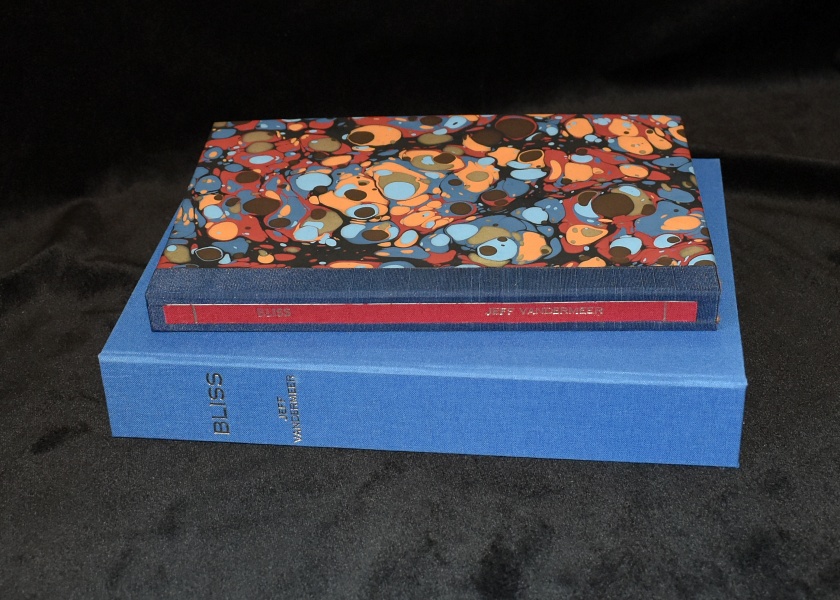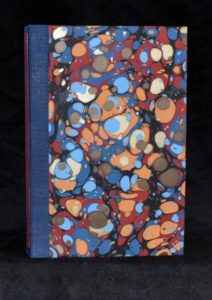In the fall of 2022, Subterranean Press published a limited edition of Bliss, by Jeff VanderMeer. In the past, whenever Subterranean Press has released editions of VanderMeer’s work, they would release it in two states, a numbered edition, and an upgraded lettered edition. For Bliss, however, they only did the numbered.
A few fans of Jeff and SubPress’s work reached out to me asking if I could re-bind their limiteds into a higher-end, traycased version that they could display with their other traycased editions. I agreed, on the following conditions: these are legally purchased books that I would be rebinding; I would not be copying Subterranean’s style, and I would not be using any Subterranean Press branding.
For this re-bind, I chose to do a sewn drum binding, following the guide from Karen Hanmer in her Guild of Bookworkers Standards of Excellence video.
I wanted to make sure I incorporated the dust jacket art somehow, but inserting it as a gatefold would make the book feel unbalanced. So instead I used it as a liner for the inside of the traycase. The dj paper had a lot of pull, so I had to use a strong paper on the other side to balance out any warp. Because the dj size wouldn’t fill the entire interior of the trays, I applied the dj to thin board first, and layered underneath with the same cloth as the edges.
wanted to make sure I incorporated the dust jacket art somehow, but inserting it as a gatefold would make the book feel unbalanced. So instead I used it as a liner for the inside of the traycase. The dj paper had a lot of pull, so I had to use a strong paper on the other side to balance out any warp. Because the dj size wouldn’t fill the entire interior of the trays, I applied the dj to thin board first, and layered underneath with the same cloth as the edges.
I also wanted to alter the signature page to ensure that this didn’t look like a lettered edition. I did this by printing the colophon on vellum paper, and gluing the paper to the signature page. I like how this method carried through the layered effects of the case.
When I had first planned out this binding, I expected to mimic more the colors of the dj, specifically the rainbow aspect. Once I received the materials in hand of the lokta papers, it was clear that something more muted would work better. I marbled some sheets with different concepts, but I wasn’t happy with what I came up with. So I went with a Renato Crepaldi paper that vibed well with the endsheets and secondary color in the interior text. I had also picked up different rainbow colored foils, and after stamping out the titling, they did not complement the marbled paper. So I switched to a classic gold. Another change from my initial concept was using cloth labels instead of leather. With such a light, airy binding, adding leather would feel off. I had already made the spine heavier and stiffer than a traditional sewn drum, and added a few millimeters more of height: adding another material would make this too busy.
One of my favorite aspects of this binding is the way the spine pops out when the book is opened. Every time I showed the bindings to friends I kept opening the books and insisting that they look at the spine. Since I wanted to keep it stiff, so I used heavy cardstock on each section of the spine (instead of just the center) to add more structure under the Japanese silk. I also glued a thin slice of the same cardstock to each edge of the center to create a depression for the label to nestle into.
I’m very, very pleased with how this binding came together, and I am grateful I was trusted to do these rebinds!
Because VanderMeer’s work is so environmentally-based, I wanted to use papers that showed as many natural fibers as possible. Therefore, I went with lokta for the endsheets, and Thai paper with inclusions for accents. You can’t see much of the Thai paper: I used it for lining the spine, and the edges of the innermost board. It was fun to cut and place since there was so much thread in the paper.
The reason this is called a “drum” binding is due to the method of adhering the different layers that make up the case. Instead of being a solid piece of bookboard, there is a center piece of thin board (covered in the multi colored paper) inserted into a board folio (covered in the orange paper). The boards are not laminated¹, but glued just at inner fold of the folio². Because you aren’t introducing a lot of moisture from gluing out the boards, you also don’t have to worry about the boards warping. The marbled paper is wrapped around the three edges, and again, only glued down at the edges. Drum refers to drumming along the edges when you are gluing down.
1: laminated in bookbinding is when you fully glue two sheets of board or paper to each other, increasing the strength.
2: folio in bookbinding is when a sheet is folded in half, this is not referring to a folio used in the common reading sense.








